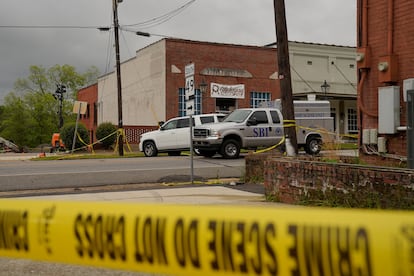The politicization of violent crime in the US ignores the numbers
According to a new study, the rate of crimes such as homicide, armed robbery and rape have declined across the country — contrary to public perception. But this fact is unlikely to impact debate on the issue, which is one of the top concerns for voters

Violent crime in the United States is down this year, but given the upcoming U.S. president election, it may be more useful to ignore that fact. Fifty-eight percent of U.S. voters believe that reducing crime should be one of the ruling government’s top priorities, and the issue is often ranked as one of their biggest concerns. So the latest trends — based on data from the FBI and the Major Cities Police Chiefs Association — should be very welcome news. But the fact that it is difficult to determine clear causes for the fall in violent crime means that, to some extent, the perception of crime is a more politically important barometer than the crime rate itself. Indeed, the political discourse and debate around violent crime ignores the numbers, which can be delicately used to support almost any thesis.
A few days ago, the Major Cities Chiefs Association (MCCA) released its statistics on violent crime — which includes homicide, rape, armed robbery and aggravated assault — for the first six months of the year. Overall, the data reflect a 6% decline compared to the previous year, with a widespread fall in nearly all the 69 cities studied. While Columbus, Ohio, saw the largest drop at 41%, Washington and Miami, traditional crime hotspots, both saw falls of 29%. Homicides were down 17% on average, with Boston and Philadelphia leading the way with 78% and 42% fewer homicides, respectively.
For David Kennedy, professor of criminal justice at John Jay College of Criminal Justice in New York and director of the National Network for Safe Communities, the numbers indicate a positive trend; although he points out that crime is often a local phenomenon, meaning national data does not give much of an indication of what may be behind it. “In a place like the United States, the national story of violent crime is really one of many local stories of violent crime. Cities don’t always move forward together: some get better while others get worse, and vice versa. But this improvement in many cities is enough to show a decided national improvement. The most important thing is that it is happening, it is real, and it is, of course, very, very good news.”
To put the decline in context, it is important to remember that national crime rates spiked during the pandemic. The current decline, Kennedy says, is a return to the pre-Covid status quo. “There are countless people who will say this happened because of the disruption of important public services during the pandemic, or because much of the period coincided with anti-police protests following the murder of George Floyd that forced services and care to be relocated away from communities where the violence was concentrated. There were also a large rise in the purchase of firearms, and the country is in the midst of the most recent phase of a national opioid epidemic. I could go on, there are many of these factors.” However, these are all theories, there is not enough information available to confirm or disprove any of them.
This means that politically — especially during a presidential election when it is a central issue — the perception of violent crime is more illustrative than the rates themselves. In other words, what voters think of reality is more important than reality. And while for a couple of years — between the Covid lockdown and the present — violent crime rates have risen in tandem with perceptions of insecurity, these two data points are now going in opposite directions. This paradox has been the norm since the “Great Crime Decline” began in the early 1990s.
Again, there is not enough data to prove any explanations for this counterintuitive phenomenon. Some blame the role of the media, which — in a bid to improve ratings with sensationalist content — disproportionately focuses on violent events and crime more broadly, and creates a false image of reality. Or political narratives that — aware of how fear can be effectively used to mobilize voters — paint an apocalyptic landscape of the world. It doesn’t matter if the data says otherwise, there will always be a city or a neighborhood to point to, or an isolated event that overshadows reality. And these arguments are almost always impossible to effectively refute due to the lack of information beyond the hard data, which can also be challenged for whatever reason.
It is no coincidence, then, that the demonization of crime is a key part of the modern-day populist’s handbook. In the United States, Donald Trump has been using this strategy since he entered politics almost a decade ago. His personal trademark has been to link allegedly rampant and rising crime to “uncontrolled” immigration, sustaining this argument with just a handful of isolate, migrant-related incidents. However, Kennedy points out, this is precisely one of the few arguments that can be reliably refuted.
“People just say ‘this is what is happening and this is what it means’ and there is no basis for having a rigorous discussion and measuring the truth of those positions. However, sometimes it is easier to say what is not happening. And, in fact, there is very strong and consistent research that says that recent immigrant populations are dramatically safer than established U.S. communities. Rates of violence and other types of crime are higher in native communities than in places where there has been recent legal and undocumented immigration. We know that clearly, the data is very clear on that,” Kennedy explains, adding that this point has had hardly any political impact: “People don’t respect it, don’t know about it, or don’t pay attention to it.”
This situation has forced the Democratic Party to show that it too can be tough on crime. Its presidential candidate, Kamala Harris, was previously California Attorney General, and she wrote a book called Smart on Crime. Despite this, Republicans are seeking to portray her as soft on crime. It’s another debate devoid of facts.
But Kennedy believes Harris should embrace her track record. While it is very difficult to name an overarching cause for the current fall in crime, the implementation of so-called evidence-based violence prevention — scientifically verified community programs to tackle the most serious types of crime — shows that there is indeed an alternative to heavy-handedness. Kennedy explains that the Biden-Harris administration was the first to recognize this new approach, provide it with national funding and roll out the programs nationwide. “Vice President Harris has been one of the strongest advocates of these new approaches, as well as what she and the administration call ‘smart policing.’ So I think there is every reason to believe that a Harris administration will continue to build on these proven approaches.”
Sign up for our weekly newsletter to get more English-language news coverage from EL PAÍS USA Edition
Tu suscripción se está usando en otro dispositivo
¿Quieres añadir otro usuario a tu suscripción?
Si continúas leyendo en este dispositivo, no se podrá leer en el otro.
FlechaTu suscripción se está usando en otro dispositivo y solo puedes acceder a EL PAÍS desde un dispositivo a la vez.
Si quieres compartir tu cuenta, cambia tu suscripción a la modalidad Premium, así podrás añadir otro usuario. Cada uno accederá con su propia cuenta de email, lo que os permitirá personalizar vuestra experiencia en EL PAÍS.
¿Tienes una suscripción de empresa? Accede aquí para contratar más cuentas.
En el caso de no saber quién está usando tu cuenta, te recomendamos cambiar tu contraseña aquí.
Si decides continuar compartiendo tu cuenta, este mensaje se mostrará en tu dispositivo y en el de la otra persona que está usando tu cuenta de forma indefinida, afectando a tu experiencia de lectura. Puedes consultar aquí los términos y condiciones de la suscripción digital.
More information
Archived In
Últimas noticias
Trump claims peace in Ukraine is near, but Moscow suggests otherwise
A survivor’s account of the Interoceanic Train accident: ‘We were scared because of the speed on the curve’
The Interoceanic Train, the Mexican alternative to the Panama Canal
What is known about the Interoceanic Train derailment in Oaxaca
Most viewed
- Oona Chaplin: ‘I told James Cameron that I was living in a treehouse and starting a permaculture project with a friend’
- Reinhard Genzel, Nobel laureate in physics: ‘One-minute videos will never give you the truth’
- Why the price of coffee has skyrocketed: from Brazilian plantations to specialty coffee houses
- Pablo Escobar’s hippos: A serious environmental problem, 40 years on
- Chevy Chase, the beloved comedian who was a monster off camera: ‘Not everyone hated him, just the people who’ve worked with him’











































